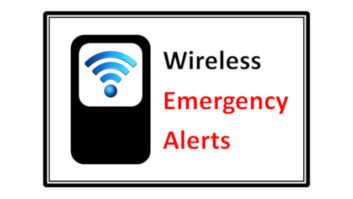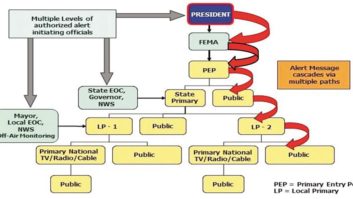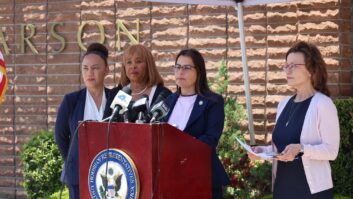The FCC this month is set to consider a Report and Order (R&O) to improve the clarity and accessibility of Emergency Alert System visual messages to the public. This includes persons who are deaf or hard of hearing who are often unable to access the audio message.
One of the changes it could adopt at its Sept. 29 monthly meeting requires EAS participants, when they receive an EAS alert in the legacy format, to check whether a CAP version of the alert is available, and if it is, to send the CAP version rather than the legacy version.
The FCC says under the current rules, if an EAS participant receives the legacy version of an alert first, it might process that version and transmit it to the public even if a CAP version of the same alert arrives seconds later. This may leave the potentially expanded content in the CAP version unused.
CAP-based alerts typically provide more information than the corresponding alerts delivered in legacy format, according to the FCC. It says the increased use of CAP-based alerts will produce higher-quality audio messages, improve the availability of multilingual alerts and ensure that more of the alerts displayed on television screens contain all of the information provided by government agencies that initiate them.
EAS participants, including radio and television broadcasters, will be required to update their EAS equipment if necessary to implement those changes.
In comments filed in the FCC’s docket to improve EAS, the National Association of Broadcasters had no objections to the FCC’s suggestions and called the proposals “reasonable” and a “worthwhile endeavor.”
NAB did tell the FCC that increasing the amount of information flowing through internet-based CAP alerts – such as a picture or more detailed text – could be problematic for radio broadcasters and a possible added expense for some.
“There seems to be no reason to force radio stations to upgrade equipment or otherwise change their current practices, given the FCC’s purpose,” wrote in its comments.
However, the R&O being considered by the FCC would direct all EAS participants, including radio broadcasters, television broadcasters and operators of satellite, cable TV, and wireline video services to check whether certain types of alerts are available in CAP format, according to the FCC document.
“We decline to grant an exception from our CAP prioritization mandate for radio broadcasters, as advocated by NAB,” the FCC said. “There are ample reasons why radio broadcasters, like video service EAS Participants, should be required to distribute CAP messages rather than legacy-formatted messages wherever possible.”
[Related: “Smarter Ways to Improve Emergency Alerts“]
The FCC continued: “First, some radio broadcasters transmit visual alerts to digital radio receivers. Further, the audio generated from a CAP alert, whether from text-to-speech or from airing a CAP audio file, typically is superior in clarity and quality to that contained in a legacy alert. And use of text-to-speech has been standardized in EAS equipment and systems for over 12 years, and it is routinely used and supported today.
“Requiring radio broadcasters to prioritize CAP alerts over legacy alerts should result in optimizing the audio quality of the alert messages they broadcast, including rendering audio messages comprehensible that might otherwise be less intelligible had the legacy audio been broadcast instead. We find improving the audio quality of alerts to be an important public interest benefit, and we therefore decline to exempt radio broadcasters from the CAP prioritization requirements.”
The FCC was persuaded that requiring CAP polling immediately upon detection of a legacy alert, as originally proposed, would be counterproductive.
It explains that when an alert is sent in both CAP and legacy formats, in many cases, the CAP version will not appear on the IPAWS server until a few seconds after EAS participants have received the legacy alert header code.
“Accordingly, a rule requiring immediate polling would fail to detect many CAP alerts by polling too early. By delaying the required polling until at least 10 seconds after receipt of the legacy alert’s initial header code, we allow sufficient time for the CAP version of the alert to appear and be retrieved, and we significantly reduce the risk that an EAS Participant will send a legacy alert when a CAP version is available,” the FCC said in the R&O.
[See Our Business and Law Page]
CAP-formatted messages are disseminated over the IPAWS platform. Triggered EAS and web-based CAP polling and prioritizing requirements for EAS participants would exclude EAN [Presidential Alert], NPT [National Periodic Test] and RWT [Required Weekly Test], the FCC says.
Currently, only video service EAS participants are required to display the messages in the form of visible content, but EAS proponents believe HD Radio could play an increased role in EAS alerting by adding visual components to radio broadcasters’ messaging.
Xperi has told the FCC that HD Radio emergency alerting is already utilized on at least 321 radio stations in the United States. HD Radio services support text and image transmission, Xperi says, and can transmit non-real-time files to support additional messaging.
The FCC R&O being circulated for tentative consideration also would improve the effectiveness of EAS by clarifying outmoded language used in connection with national emergency alerts for video-based services like TV stations, including how such alerts are visually displayed. Such an alert would label it as a “National Emergency Message” and the alert originator as the “United States Government” if the R&O is adopted.
In addition, the message sent to the public during national EAS tests would announce a “Nationwide Test of the Emergency Alert System” rather than a “National Periodic Test,” according to the FCC.
The FCC monthly meeting is scheduled for Sept. 29 at 10:30 a.m. EDT in the Commission Meeting Room of the Federal Communications Commission in Washington, D.C.
There is a lot going on around EAS; Rosenworcel recently announced that she is circulating another proposal aimed at improving the cybersecurity of the alerting system. But that NPRM does not appear on the list of agenda items released by her office for the September meeting.






